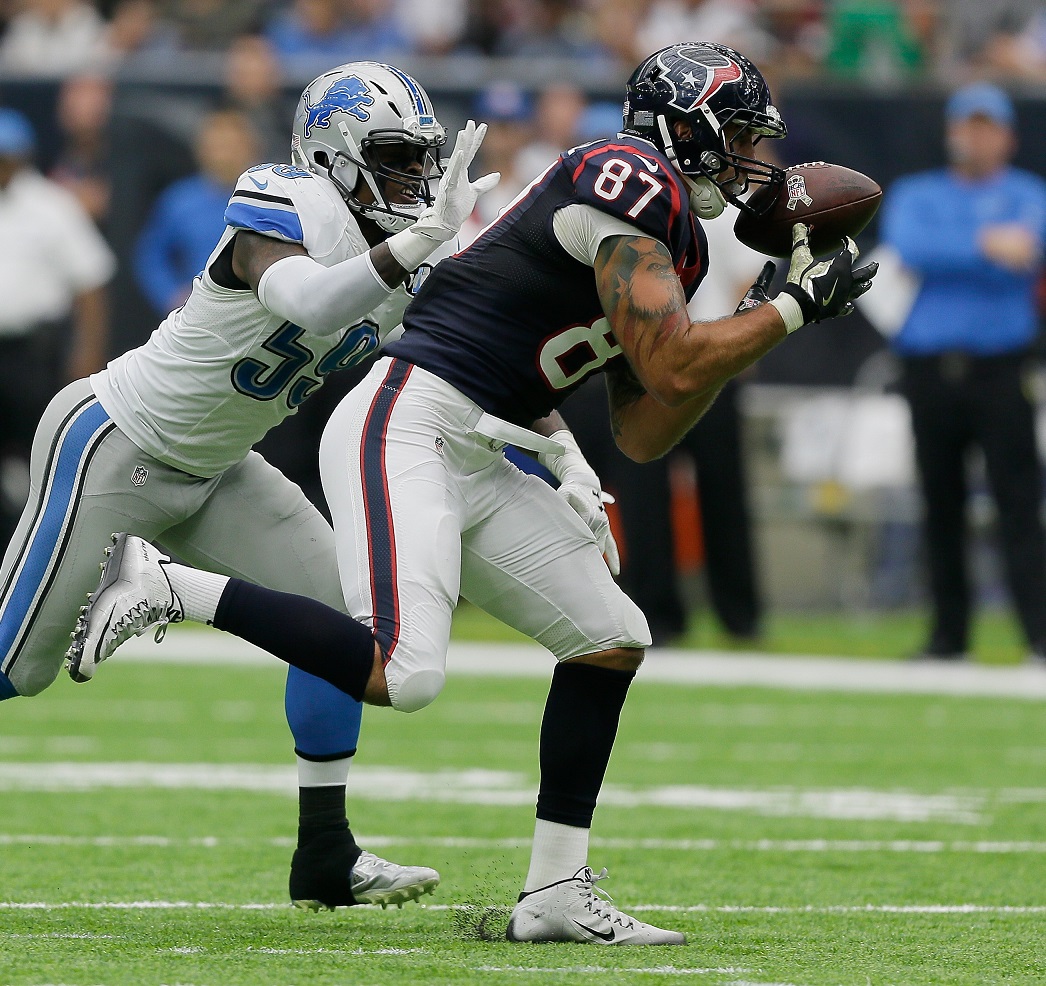All this year, I’ve been getting Twitter questions about which tight end someone should play, and I shudder every time. It feels like everyone I suggest is an abject failure.
It used to be that at least Rob Gronkowski was a safe play, but due to injury, he was a decoy on numerous occasions and now he’s out for the remainder of the season after having back surgery.
When not even the Gronk is a safe call, what is there left to hold onto?
(Want a PFF subscription? Click here to sign up for Fantasy Gold, DFS Pro or All Access.)
First, it’s not in your head.
And if you’re playing in standard, it’s even harder to predict. I’ll get to that later, but it’s bad in all formats.
Here are the average points per game of the top-10 players at the tight end position over the last five years in standard scoring:
2012 – 7.92 points per game
2013 – 8.87 points per game
2014 – 8.61 points per game
2015 – 9.03 points per game
2016 (so far) – 7.89 points per game
Yes, if you play in standard leagues, tight ends are scoring at the lowest points-per-game average over the last five years.
(It’s PFF Fantasy’s free content week. Keep up with all our free offerings here.)
Here are the average points per game for the top 10 players in PPR formats:
2012 – 13.01 points per game
2013 – 13.5 points per game
2014 – 13.17 points per game
2015 – 13.93 points per game
2016 (so far) – 12.29 points per game
And the hits keep coming. Of the top 10 tight ends in the league right now, Zach Miller is out for the season, Jordan Reed continues to struggle with a variety of injuries, and things are so bad that even Coby Fleener could break the top 10 in scoring in PPR formats. If you’ve seen his game log, you know we’re in dire straits.
What can we do?
I’m going to cut right to the chase because the numbers speak for themselves.
If you play in standard scoring, you need a player with touchdown upside. Volume is not going to win you the game, contrary to popular opinion. If your tight end doesn’t score a touchdown, he is unlikely to break the 10-point barrier.
In the first 13 weeks of the season, five of those weeks had a 100-percent rate of tight ends with 10-plus fantasy points also scoring a touchdown in standard scoring. Every week, at least 71.4 percent of the 10-plus-point players had a touchdown.
That’s because tight ends are not getting yards. There have only been 22 total 100-plus yard performances from a tight end this year. That’s only 1.5 players per week with a chance at that kind of yardage. Only 37 tight ends have gone for more than 75 yards in a game, 2.8 players per week. Since Week 10, only Delanie Walker, Martellus Bennett, Travis Kelce (three times), Jared Cook and Ladarius Green surpassed 100 yards.
Even in PPR leagues, the pickings are slim. Since Week 8, at least 53 percent of the 10-plus point performances came from tight ends with touchdowns. There are more 10-plus-point fantasy performances based on the PPR element of the scoring, but the overall scoring has dipped to a point where you have to take the touchdown upside into account more than ever.
So, being touchdown dependent isn’t so terrible?
No. In fact, it’s necessary.
Carolina, Detroit and Cleveland have given up nine touchdowns this season to opposing tight ends, a league-high. Behind them, Atlanta, Miami and Cincinnati have allowed seven. The Jets have allowed six (three of which came Monday night).
The Arizona Cardinals have yet to give up a touchdown to opposing tight ends, so if you play in standard scoring (or if you play DFS) you cannot really justify start a tight end going up against the Cardinals, ever.
Also, while looking at matchups, look deeper. The Giants are supposedly a good matchup for tight ends, but they have only given up three total touchdowns all season. They give up more receptions and yardage, but the likelihood of breaking through to a double-digit performance is lower, depending on format.
Player suggestions for the playoffs and DFS
Clearly, Dwayne Allen was a baller Monday night with three touchdowns. We can safely say that’s his ceiling, but he’s worth considering every week moving forward. The only knock on Allen has been his health. He’s only played in 10 games this season, and not all at full health.
Every week, I tell you to consider C.J. Fiedorowicz. (So does everyone else at PFF.) He’s averaging 10.5 yards per reception — despite having Brock Osweiler as his quarterback — and is scoring the fourth-most PPR points per opportunity (0.49) among all tight ends, behind only Rob Gronkowski (out), Hunter Henry, and Jordan Reed (out for now at least).
And Henry… he’s the boom-or-bust tight end that is worth playing due to his touchdown upside. Second in the league in points per opportunity in standard and PPR leagues, you need to grab him now before someone else does.
The Washington Redskins throw more to their tight end than any other team in the league. I’m not completely off of the “opportunities = points” bandwagon. You will always play Jordan Reed, and Vernon Davis must be owned in all formats. They will score points.
But honestly, I suggest playing the matchups moving forward. You want to play the tight ends facing the defenses I mentioned above due to the dearth of fantasy points that are available to you.
Every year, there’s a threshold at tight end, below which you’ll be streaming at the position. This year, though, that threshold is higher than it’s ever been, and fantasy players must adjust accordingly.



 © 2024 PFF - all rights reserved.
© 2024 PFF - all rights reserved.